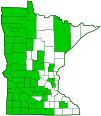rough bugleweed
(Lycopus asper)
Conservation • Wetland • Description • Habitat • Ecology • Use • Distribution • Taxonomy
Description |
||
Rough bugleweed is an erect, perennial forb that rises on a solitary stem from a long, slender, horizontal rhizome and fibrous roots. It can be 8″ to 40″ tall, though it is usually no more than 24″ in height. The rhizome has a tuber at the tip from which next year’s stem will rise. It does not produce an above-ground runner (stolon). The stems are erect, stout, usually unbranched, green, square, and hollow. There are minute to short spreading hairs at least on the angles, however this character is unreliable (Voss). There is a single vertical groove on each side of the stem. The leaves are opposite, unlobed, and usually unstalked. They are narrowly oblong to inversely lance-shaped, 1½″ to 4″ long, and ¼″ to 1⅜″ wide. They become progressively smaller as they ascend the stem. Each pair of opposite leaves is at right angles to the leaf pairs above and below it. The leaf blades taper to a point at the tip and usually taper to a broad base at the point of attachment with the stem. The upper surface is sometimes hairless, often rough to the touch due to minute, stiff hairs. The lower surface is hairless. The margins are coarsely and evenly toothed with sharp, forward-pointing teeth. Although this is a mint, when crushed the leaves do not smell of mint. The inflorescence is a tight cluster of stalkless flowers in the leaf axils on the upper ⅔ of the stem. Pairs of clusters in opposite leaf axils form false whorls. There are 5 green sepals (calyx) that are united for most of their length into a 1 ⁄16″ to ⅛″ long, bell-shaped tube with 5 teeth. The calyx teeth are 1 ⁄16″ to ⅛″ long, firm, and awl-shaped. There are 5 white petals (corolla) that are united at the base into a tube, then separated at the tip into 4 lobes. The corolla is slightly longer than the calyx. There are 2 fertile stamens with brown anthers and 2 sterile stamens (staminodes). The stamens and the style are longer than corolla tube. The staminodes are club-like and are shorter than the corolla tube. The flowers are not fragrant. The fruit is a set of 4 egg-shaped, brown, hairless, ridged nutlets with one seed each. The inner angle is shorter than the outer ones so that the center of the nutlets is depressed. When the fruit is mature the calyx lobes distinctly surpass the mature nutlets. The ridges on the nutlets are corky, aiding dispersal by allowing the nut to float on water. |
||
Height |
||
8″ to 24″ |
||
Flower Color |
||
White |
||
Similar Species |
||
Rough bugleweed is most easily distinguished by its long, narrow leaves that are unlobed, unstalked, and broad at the base. American bugleweed (Lycopus americanus) does not produce tubers. The leaves are broader and taper at the base to a short stalk. The lower leaves are lobed near the base. Northern bugleweed (Lycopus uniflorus) produces a stolon with a tuber at the tip. The rhizome does not produce tubers. The leaves are shorter, no more than 2⅜″ long, and taper at the base to a distinct stalk. The corolla has 5 lobes, not 4. When the fruit is mature the nutlets surpass the calyx lobes. Sherard’s waterhorehound (Lycopus X sherardii) is a hybrid between this species and Virginia bugleweed. It is found wherever the ranges of the two species overlap. Virginia bugleweed (Lycopus virginicus) does not produce tubers. The leaves are hairy on the upper and lower surfaces. The leaf margins are toothed from just below the middle to the tip, and untoothed and long concave-tapered below that point. The stamens are shorter than corolla tube. The cluster of 4 nutlets is flat across the top, not depressed. When the fruit is mature the nutlets surpass the calyx lobes. |
||
Habitat |
||
Wet or moist. Marshes, wet meadows, fens, stream banks, ditches, lake shores. Partial sun or full shade. |
||
Ecology |
||
Flowering |
||
July to September |
||
Pests and Diseases |
||
|
||
Use |
||
|
||
Distribution |
||||
|
Sources |
|||
| 5/21/2023 | ||||
Nativity |
||||
Native |
||||
Occurrence |
||||
|
||||
Taxonomy |
|||
| Kingdom | Plantae (Plants) | ||
| Division | Tracheophyta (Vascular Plants) | ||
| Subdivision | Spermatophytina (Seed Plants) | ||
| Class | Magnoliopsida (Dicots) | ||
Order |
Lamiales (Mints, Plantains, Olives, and Allies) | ||
Family |
Lamiaceae (Mint) | ||
| Subfamily | Nepetoideae | ||
| Tribe | Mentheae | ||
Subtribe |
Lycopinae (water horehound) | ||
| Genus | Lycopus (water horehounds) | ||
Lycopus was formerly placed in the subtribe Menthinae. A recent comprehensive phylogenetic analysis of the tribe Mentheae of the family Lamiaceae (Drew and Sytsma, 2012) showed strong support for separating the genus Lycopus into a separate subtribe Lycopinae. The move has not been universally accepted. |
|||
Subordinate Taxa |
|||
|
|||
Synonyms |
|||
Lycopus lucidus Lycopus lucidus ssp. americanus Lycopus lucidus var. americanus |
|||
Common Names |
|||
rough bugleweed rough water-horehound western water-horehound |
|||
Glossary
Axil
The upper angle where a branch, stem, leaf stalk, or vein diverges.
Calyx
The group of outer floral leaves (sepals) below the petals, occasionally forming a tube.
Corolla
A collective name for all of the petals of a flower.
Rhizome
A horizontal, usually underground stem. It serves as a reproductive structure, producing roots below and shoots above at the nodes.
Sepal
An outer floral leaf, usually green but sometimes colored, at the base of a flower.
Staminode
A modified stamen that produces no pollen. It often has no anther.
Stolon
An above-ground, creeping stem that grows along the ground and produces roots and sometimes new plants at its nodes. A runner.
Visitor Photos |
|||||
Share your photo of this plant. |
|||||
| This button not working for you? Simply email us at info@MinnesotaSeasons.com. Attach one or more photos and, if you like, a caption. |
|||||
|
|||||
MinnesotaSeasons.com Photos |
|||||
Plant |
|||||
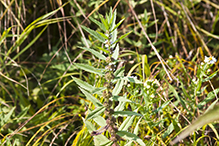 |
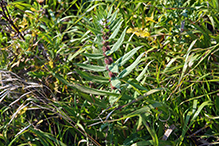 |
||||
Inflorescence |
|||||
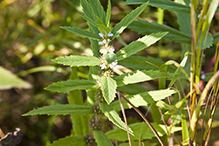 |
|||||
Leaves |
|||||
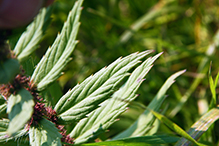 |
|||||
Infructescence |
|||||
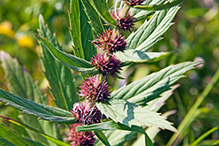 |
|||||

Slideshows |
||

Visitor Videos |
|||
Share your video of this plant. |
|||
| This button not working for you? Simply email us at info@MinnesotaSeasons.com. Attach a video, a YouTube link, or a cloud storage link. |
|||
Other Videos |
|||

Visitor Sightings |
|||||
Report a sighting of this plant. |
|||||
| This button not working for you? Simply email us at info@MinnesotaSeasons.com. Be sure to include a location. |
|||||
|
|||||
MinnesotaSeasons.com Sightings |
|||||

|
Created: Last Updated: © MinnesotaSeasons.com. All rights reserved. |
